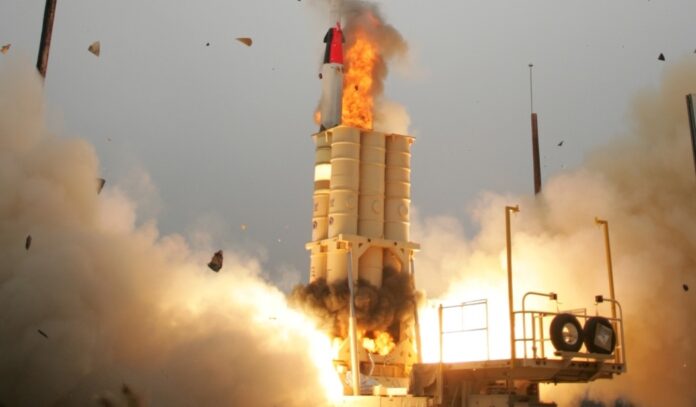On Monday, Israel shot down a ballistic missile in flight outside of the Earth’s atmosphere. This marks a historical first time that an anti-ballistic missile has successfully intercepted a target in space during combat. The missile was fired by Houthi rebels in Yemen and was targeting Israel. The Israel Defense Forces (IDF) used their Arrow anti-ballistic missile defense system, which is a joint American-Israeli project first deployed in Israel over 20 years ago.
While the Israel Defence Forces (IDF) has released few details about the interception, the Air Force is known to operate several batteries of the Arrow 2 system, which uses a hypersonic interceptor to take out incoming missiles in space.
The Israeli defence ministry released a video showing the moment of interception, with the faint cylindrical shape of the incoming ballistic missile barely visible in the false-colour image, before an explosion smears across the screen.
In a statement, the IDF said that air force systems tracked the missile’s trajectory and intercepted it “at the most appropriate operational time and location”.
The missile, which was classified as a Qadr-110 Intermediate Range Ballistic Missile (IRBM), is an improved version of the Iranian-designed Shahab-3 ballistic missile. It is approximately 52 feet long and four feet wide, weighs just over 37,400 pounds, and has a range of just over 1,200 miles. The missile has the ability to carry a conventional or nuclear warhead and can carry a warhead of up to 2,200 pounds.
The Arrow anti-ballistic missile system was designed specifically to deal with these types of threats and is also capable of intercepting land or sea-based cruise missiles as well. The IDF used this system before in 2017 when it successfully intercepted a Syrian S-200 surface-to-air missile, which was fired at an Israeli aircraft but missed and veered off-course in the direction of Israel. The missile is approximately 6,200 pounds, 23 feet long, and has a two-stage body. It has a top speed of MACH 9, which means it is capable of high hypersonic speeds and carries a 330-pound high-explosive warhead.
Houthi rebels in Yemen have declared war on Israel and have launched numerous attacks against Israel in the past weeks. Most notably was when Houthi rebels launched several land-attack cruise missiles and several drones, which were intercepted by a US Navy Destroyer. The USS Carney, a guided missile destroyer tasked primarily with anti-air defense, used SM-3 anti-aircraft missiles to down the Houthi cruise missiles and drones. Additionally, the Israeli Air Force used their newly acquired F-35I to successfully intercept and destroy another Houthi cruise missile last Thursday for another first in this war. While the IDF was tight-lipped on the exact details, the F-35I carries the short-range AIM-9X infrared tracking air-to-air missile, along with the AIM-120 Advanced Medium Range Air-to-Air Missile (AMRAAM).
Israeli F-35I Adir shoots down cruise missile launched by Houthi group from Yemenhttps://t.co/wW5ZfKwQz6 pic.twitter.com/uUkcdshmfH
— Roni Sontani (@Roni_Sont) November 3, 2023
These recent events are very important for a few reasons. For one, as I previously mentioned, Israel shooting down a hostile ballistic missile while still in space is a major first for the entire world. No other nation has done this before, and it also proves that Americans and the Israelis now have the proven capability to successfully intercept inbound ballistic tracks at hypersonic speeds. This means it should be able to successfully interpret hypersonic cruise missiles that have been developed by Russia and China.
Secondly, the fact that the Houthi rebels in Yemen are in possession of very sophisticated weapon systems is very concerning. While the weapons they have in hand are unable to target the American homeland, they have the range to target American assets in the region, as well as our partner allies. Depending on where some of the weapons are fired, they can reach as far north as Baghdad, Israel, and Kuwait. The cruise missiles they have can also reach several targets in the region, especially naval vessels and civilian merchant traffic. The ballistic missiles being supplied by Iran are also nuclear-capable, as stated earlier. While officially, America has no evidence (that has been publicly confirmed) that Iran has been able to secure nuclear weapons, their Qadr-110 missile theoretically could be fitted with a nuclear device obtained through either North Korea, Russia, or China. Admittedly, that would be a far-fetched scenario, but it is within the realm of plausibility. These recent events should be concerning to us all, if not just for the historical aspect of it all.




